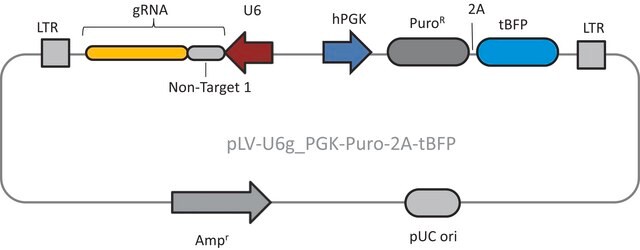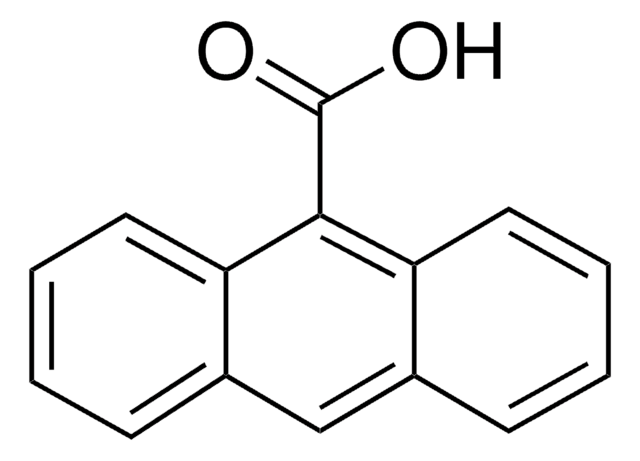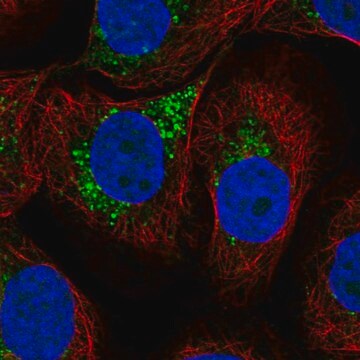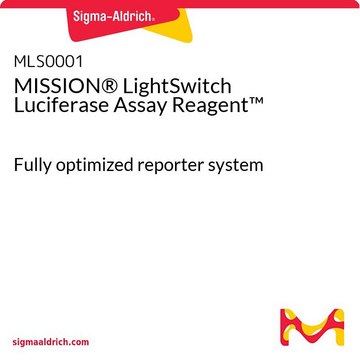NCSTUD001
MISSION® Synthetic microRNA Inhibitor
ath-miR416, Negative Control 1, Sequence from Arabidopsis thaliana with no homology to human and mouse gene sequences
Synonym(s):
Synthetic Tough Decoy, sTuD
Sign Into View Organizational & Contract Pricing
All Photos(1)
About This Item
UNSPSC Code:
12352200
NACRES:
NA.51
Recommended Products
product line
MISSION®
form
solid
mature sequence
GGUUCGUACGUACACUGUUCA
Sanger mature/minor accession no.
Sanger microRNA accession no.
storage temp.
−20°C
Looking for similar products? Visit Product Comparison Guide
General description
Individual synthetic microRNA inhibitors were designed using a proprietary algorithm, which is based on the work of Haraguchi, T, et al. and in collaboration with Dr. Hideo Iba, University of Tokyo.† This algorithm utilizes the tough decoy (TuD) design. miRNA are known to regulate gene expression in a variety of manners, including translational repression, mRNA cleavage and deadenylation.
The MISSION synthetic miRNA Inhibitors are small, double-stranded RNA molecules designed to inhibit a specific mature miRNA. The miRNA inhibitors were designed using the mature miRNA sequence information from miRBase and are 2′-O-methylated RNA duplexes with a miRNA binding site on each strand. Optimal miRNA inhibition is provided after transfection due to the robust secondary structure of the inhibitor.
The MISSION synthetic miRNA Inhibitors are small, double-stranded RNA molecules designed to inhibit a specific mature miRNA. The miRNA inhibitors were designed using the mature miRNA sequence information from miRBase and are 2′-O-methylated RNA duplexes with a miRNA binding site on each strand. Optimal miRNA inhibition is provided after transfection due to the robust secondary structure of the inhibitor.
- Long lasting inhibition at very low dosage
- Excellent resistance to cellular nucleases
- Custom synthesis available for a variety of species
Other Notes
Based on miRBase V19
Legal Information
MISSION is a registered trademark of Merck KGaA, Darmstadt, Germany
Signal Word
Warning
Hazard Statements
Precautionary Statements
Hazard Classifications
STOT RE 2 Inhalation
Target Organs
Respiratory Tract
Storage Class Code
11 - Combustible Solids
WGK
WGK 3
Flash Point(F)
Not applicable
Flash Point(C)
Not applicable
Choose from one of the most recent versions:
Certificates of Analysis (COA)
Lot/Batch Number
It looks like we've run into a problem, but you can still download Certificates of Analysis from our Documents section.
If you need assistance, please contact Customer Support.
Already Own This Product?
Find documentation for the products that you have recently purchased in the Document Library.
Ilker Tinay et al.
The Prostate, 78(12), 927-937 (2018-05-12)
MicroRNAs (miRNAs) are small non-coding RNAs, which negatively regulate gene expression and impact prostate cancer (PCa) growth and progression. Circulating miRNAs are stable and detectable in cell-free body fluids, such as serum. Investigation of circulating miRNAs presents great potential in
Qing-Yan Lin et al.
Biotechnology letters, 42(1), 35-44 (2019-11-25)
The study is to research how miR-34-SIRT1 is regulated during hypoxia in lung cancer cells. Analysis of publicly available datasets from patients with NSCLC did not reveal significant genomic alterations in RBM38, SIRT1, HIF1A, MIR34A, MIR34B, and MIR34C, but expectedly
Yao Dai et al.
Redox biology, 16, 255-262 (2018-03-20)
Several miR/s that regulate gene/s relevant in atherogenesis are being described. We identified a miR (miR-98) that targets LOX-1, a receptor for ox-LDL, and speculated that it might be relevant in atherogenesis. MicroRNA-98 was predicted by bioinformatics tools. The effects
Let-7a-regulated translational readthrough of mammalian AGO1 generates a microRNA pathway inhibitor.
Anumeha Singh et al.
The EMBO journal, 38(16), e100727-e100727 (2019-07-23)
Translational readthrough generates proteins with extended C-termini, which often possess distinct properties. Here, we have used various reporter assays to demonstrate translational readthrough of AGO1 mRNA. Analysis of ribosome profiling data and mass spectrometry data provided additional evidence for translational
Our team of scientists has experience in all areas of research including Life Science, Material Science, Chemical Synthesis, Chromatography, Analytical and many others.
Contact Technical Service








